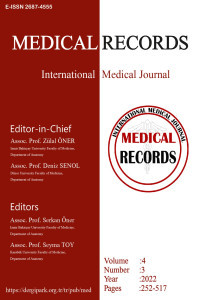Quantitative Assessment of the Pharyngeal Recess Morphometry in Anatolian Population Using 3D Models Generated from Multidetector Computed Tomography Images
Quantitative Assessment of the Pharyngeal Recess Morphometry in Anatolian Population Using 3D Models Generated from Multidetector Computed Tomography Images
3D slicer, multidetector computed tomography, nasopharyngeal carcinoma, nasopharynx, pharyngeal recess,
___
- 1. Mudry A. Pharyngeal recess or Rosenmuller's fossa: Its first description revisited. Head Neck. 2021;43:2295-6.
- 2. Amene C, Cosetti M, Ambekar S, et al. Johann Christian Rosenmuller (1771-1820): A historical perspective on the man behind the fossa. J Neurol Surg B Skull Base. 2013;74:187-93.
- 3. Chen YP, Chan ATC, Le QT, et al. Nasopharyngeal carcinoma. Lancet. 2019;394:64-80.
- 4. Erdem S, Zengin AZ, Erdem S. Evaluation of the pharyngeal recess with cone-beam computed tomography. Surg Radiol Anat. 2020;42:1307-13.
- 5. Mankowski NL, Bordoni B. Anatomy, head and neck, nasopharynx. Treasure Island (FL): StatPearls Publishing. https://www.ncbi.nlm.nih.gov/books/NBK557635/ access date 25.05.2023.
- 6. Tang Y, Bie X, Yu S, Sun X. Study of the anatomical structure of the nasopharyngeal cavity and distribution of the air flow field. J Craniofac Surg. 2020;31:1937-41.
- 7. King AD, Zee B, Yuen EH, et al. Nasopharyngeal cancers: Which method should be used to measure these irregularly shaped tumors on cross-sectional imaging? Int J Radiat Oncol Biol Phys. 2007;69:148-54.
- 8. Chen J, Luo J, He X, Zhu C. Evaluation of contrast-enhanced computed tomography (CT) and magnetic resonance imaging (MRI) in the detection of retropharyngeal lymph node metastases in nasopharyngeal carcinoma patients. Cancer Manag Res. 2020;12:1733-9.
- 9. Sutthiprapaporn P, Tanimoto K, Ohtsuka M, et al. Improved inspection of the lateral pharyngeal recess using conebeam computed tomography in the upright position. Oral Radiol. 2008;24:71-5.
- 10. Erdem H, Cevik Y, Safak NK, et al. Morphometric analysis of the infratemporal fossa using three-dimensional (3D) digital models. Surg Radiol Anat. 2023;45:729-34.
- 11. Guo R, Mao YP, Tang LL, et al. The evolution of nasopharyngeal carcinoma staging. Br J Radiol. 2019;92:20190244.
- 12. Koo TK, Li MY. A guideline of selecting and reporting intraclass correlation coefficients for reliability research. J Chiropr Med. 2016;15:155-63.
- 13. Tang LL, Chen YP, Chen CB, et al. The chinese society of clinical oncology (CSCO) clinical guidelines for the diagnosis and treatment of nasopharyngeal carcinoma. Cancer Commun (Lond). 2021;41:1195-227.
- 14. Jacobs R, Salmon B, Codari M, et al. Cone beam computed tomography in implant dentistry: recommendations for clinical use. BMC Oral Health. 2018;18:88.
- 15. MacDonald D. Cone-beam computed tomography and the dentist. J Investig Clin Dent. 2017;8:10.
- 16. Sutthiprapaporn P, Tanimoto K, Ohtsuka M, et al. Positional changes of oropharyngeal structures due to gravity in the upright and supine positions. Dentomaxillofac Radiol. 2008;37:130-5.
- 17. Kaplan FA, Bayrakdar IS, Bilgir E. Evaluation of rosenmuller fossa with cone beam computed tomography: A retrospective radio-anatomical study. Selcuk Dent J. 2019;6:195-9.
- 18. Kaplan FA, Saglam H, Bilgir E, et al. Radiological evaluation of the recesses on the posterior wall of the nasopharynx with cone-beam computed tomography. Niger J Clin Pract. 2022;25:55-61.
- 19. Loh LE, Chee TS, John AB. The anatomy of the fossa of rosenmuller: Its possible influence on the detection of occult nasopharyngeal carcinoma. Singapore Med J. 1991;32:154- 5.
- 20. Serindere G, Gunduz K, Avsever H, Orhan K. The anatomical and measurement study of rosenmuller fossa and oropharyngeal structures using cone beam computed tomography. Acta Clin Croat. 2022;61:177-84.
- 21. Takasugi Y, Futagawa K, Konishi T, et al. Possible association between successful intubation via the right nostril and anatomical variations of the nasopharynx during nasotracheal intubation: A multiplanar imaging study. J Anesth. 2016;30:987-93.
- Yayın Aralığı: Yılda 3 Sayı
- Başlangıç: 2019
- Yayıncı: Zülal ÖNER
Fadime BEYAZYÜZ, Elif GÜLBAHÇE MUTLU, Serife ALPA, Fatma Zehra ERBAYRAM, Fatma Nur TÜRKOĞLU, Şemsettin KULAÇ
Evaluation of the Effect of COVID-19 on Patients Undergoing Orthodontic Treatment
Hilal YILANCI, Kevser KURT DEMİRSOY, Barış CANBAZ, Servet BOZKURT, Duygu SEVGİ
Selim ÇINAROĞLU, Hasan AKKAYA, Hacı KELEŞ, Fatih ÇİÇEK
Mahmut Zabit KARA, Mehmet Hamdi ÖRÜM, Ayşe Sevgi KARADAĞ, Aysun KALENDEROĞLU
Can Cranium Size be Predicted from Orbit Dimensions?
Ankle Bone Anatomy in Turkish Population: A Radiological Study
Aybars KIVRAK, İbrahim ULUSOY, Mehmet YILMAZ
Ahmet YABALAK, Muhammed Nur ÖĞÜN
Prediction of Short or Long Length of Stay COVID-19 by Machine Learning
Muhammet ÖZBİLEN, Zübeyir CEBECİ, Aydın KORKMAZ, Yasemin KAYA, Kaan ERBAKAN
The Use of Botulinum Toxin in Temporomandibular Disorders: A Bibliometric Study
Serkan YILDIZ, Feridun ABAY, S. Kutalmış BÜYÜK
Lomber Disk Hernili Hastalarda Q açısı ve Hamstring Uzunluğunun Denge Performansına Etkisi
